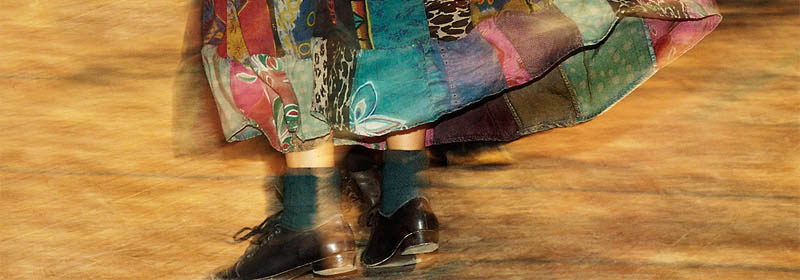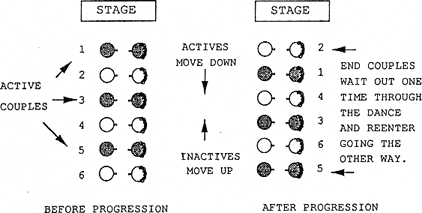The Contra Dance Tradition
The contra dance uses figures similar to those used in square dance, but it is danced in opposing lines rather than in a square formation. The "Virginia Reel" is perhaps the dance most familiar to the general public that uses the contra dance formation. Dancers stand opposite their partners in a long line, with the men forming a line on the caller's right, and the women forming an opposing line on the caller's left:
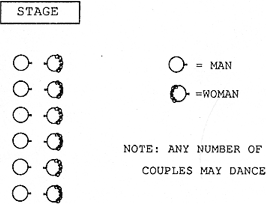
Figure 1. The Contra Dance Line
Essential to the concept of the contra dance is the idea of progression. In a typical contra dance, each couple dances with one other couple next to them in the line. Each time through the dance, in the course of executing the figures, the couples move either up the set or down the set one place. Most commonly the first, third, fifth, and other odd-numbered couples, or active couples (numbered from the head of the set, the end closest to the band) move down the set one place during a single repetition of the dance, and the even-numbered couples, or inactive couples, move up the set one place in the same time period. (Down the set means away from the music and up the set means toward the music.) If the dance continues long enough, a single couple may move all the way to the bottom of the set as an active couple, and then move all the way back to the top of the set as an inactive couple. This movement is what is meant by the progression. The progression allows every couple in a set to dance with every other couple in the set, which is one of the distinctive and delightful features of the contra dance formation.
The dance figures themselves resemble and in many cases are identical to the figures many of us associate with square dance, figures such as the "star," the "circle," and the "dosido." They are generally danced within a subset of four people (called a "minor set") consisting of one active couple and the inactive couple below them.
To make clear how the contra dance works, I will present two examples. The first is a dance called "British Grenadier," which is a traditional dance. The second is a dance called "The Ritz," and it is a recently composed dance.
This is the way the dance "British Grenadier" would look written on a typical dance caller's cue card (Adapted from Jennings 1983:38) :
BRITISH GRENADIER
A1 Actives down the outside and back to place.
A2 Actives down the center, turn individually, come back and cast off with the inactives.
B1 Star right, star left
B2 Right and left through across the set, and back again.
The tunes used for contra dancing usually consist of four eight-bar phrases in the form AABB, to which the A1, A2, B1 and B2 refer in the dance notes above. Next to the letter for each phrase is a description of the dance movements that take place during that
phrase.
"British Grenadier" is danced in the proper formation (see Appendix). This means that the men all stand in one line and the woman in the other:
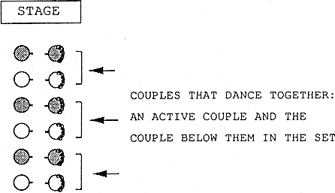
Figure 3. The Proper Formation
As the dancers line up, they figure out who is active and who is inactive by taking hands in their minor sets of four people all the way down the line. When the dancers are ready, the caller leads them in a walk-through of the dance.
During the first eight bars of music, the odd-numbered couples, or active couples, are instructed to separate from one another and go down the outside of the set, turn, and come back to place:
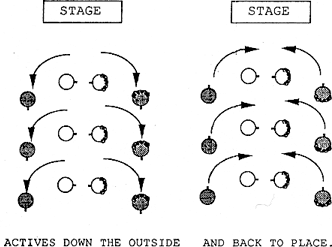
Figure 4. Down the Outside and Back in "British Grenadier"
During the second eight bars of music these same couples go down the center of the set together, turn individually, and come back almost to place. When they reach the inactive couple with whom they are dancing the active couples do a "cast off" around the inactive couple by holding them at the waist and turning around with them until they are back in line again. The result of this maneuver is that the active couples have progressed one place down the set, where they remain for the rest of the dance sequence. This establishes the progression (see Appendix).
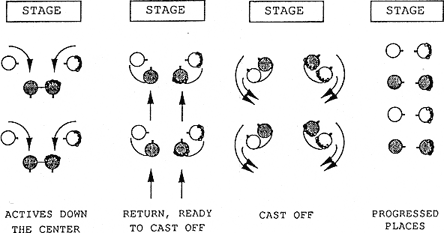
Figure 5. Cast Off in "British Grenadier"
During the third eight bars of the music the active couple and the inactive couple make a "right hand star" by placing all their right hands together and walking around in a little circle; they then turn to face the other way, place their left hands together, and walk back to place in a "left hand star."
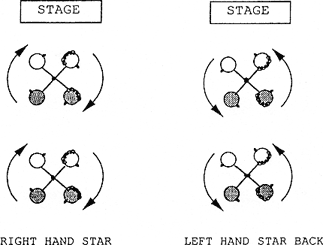
Figure 6. The Star in "British Grenadier"
During the last eight bars of the music the dancers in the subset of four walk across the set passing right shoulders with their partners, turn together with their neighbors, and in like manner cross the set again and turn back to place. This figure is called a "right and left through."
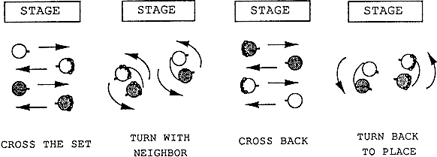
Figure 7. Right and Left Through in "British Grenadier"
This completes one round of the dance. To begin the next round, the active couples separate and go down the outside of the set again, passing first the new inactive couple with whom they will dance during this new round of the dance.
"British Grenadier" exhibits a number of features typical of the traditional contra dance. The dance uses the proper formation, which was most common in the dances collected by Holden in the 1950s and is now relatively rare. The "cast off" is used to accomplish the progression—a figure which does not fit in well with today's more symmetrical dances, because it gives the active couples most of the action. Both the "star" and the "right and left through" are made up of symmetrical halves, the "star" going right and then back to the left, and the "right and left through" going across the set and back again. In today's dances the figures that either revolve or cross the set are most often done in only one direction and the return is accomplished in some other way, if at all. Finally, "British Grenadier" has no swing, which is seldom the case in contemporary dances.
Here is what a dance card for "The Ritz" looks like (Hubert 1986:5):
THE RITZ, BY GENE HUBERT
A1 Right hand star once and a quarter around. Allemande left with the next person along the line.
A2 Balance and swing your partner.
B1 Lines go forward and back. Ladies chain across.
B2 Hey for four starting with the women passing right shoulders in the center.
This dance is an example of a modern composed contra dance. It begins in the improper formation. This means that after the dancers have lined up with the men on one side and the women on the other, the caller will ask the active couples to change places with their partners, which results in two lines of alternating gender like this:
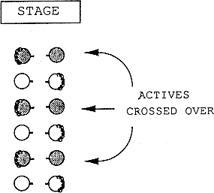
Figure 8. The Improper Formation
The dance begins with a "right hand star" within each set of four dancers. Dancers take right hands with one another in one of several possible holds, and they turn the "star" once and then a quarter more, so each dancer ends up one place farther around the little circle than he or she started. The use of fractional turns is very common in today's composed contra dances.
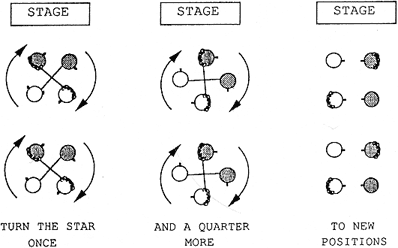
Figure 9. Star Once and Three-Quarters in "The Ritz"
The next move is an "allemande left" once around (a hand turn using the left hand) with the next person in line. This new person is not in the minor set with whom most of the dance is executed. This too is typical of many of the modern dances where the dance figures expand to include dancers from neighboring subgroups. The "star" and the "allemande" together make up the first A part of the music.
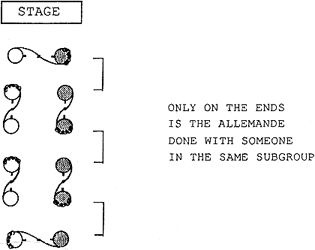
Figure 10. Allemande Left in "The Ritz"
Dancers are now standing on the same side of the set as their partners, and the next figure is a "balance and swing" with one's partner for everybody. In the traditional dances partner swings tend to be only for the active couples, and tend to occur in the center of the set. In the modern dances partner swings are generally for everyone, and occur on the sides of the sets so there will be room for everyone to swing at once. The standard "balance" involves each dancer stepping on the left foot and kicking up the right (or vice versa), and then stepping on the right foot and kicking up the left (or vice versa). The "swing" is in ballroom position and is done with a buzz step (see Appendix). The "balance and swing" fill the second A part of the music.
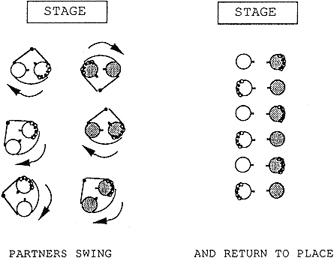
Figure 11. Swing in "The Ritz"
Next the dancers take hands in the long lines comprising the contra set and in these long lines they walk forward four steps toward the other line, and then back up four steps to place.
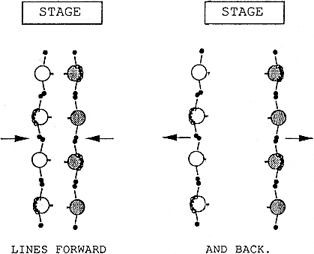
Figure 12. Lines Forward and Back in "The Ritz"
The "ladies chain" follows. In this figure the two women take right hands and walk past each other to the other side of the set, where they are turned by the man on that side. In this dance they do not chain back across the set. The half chain finishes the progression, since the women are turned to the right hand side of the opposite man, one place away from where they started the dance.
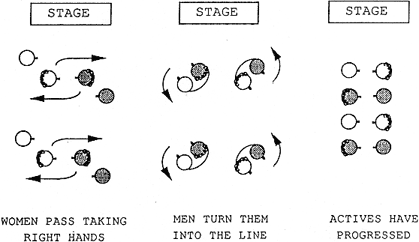
Figure 13. Half Ladies Chain in "The Ritz"
The final B part of the music accompanies a "hey for four" which begins with the ladies passing by the right shoulders and the men following in a weaving figure which eventually brings everyone back to their original position. The "hey" is a figure from English country dance that was incorporated into the American contra dance during the 1970s. Now an evening of contra dance rarely goes by in which there is not at least one dance with a "hey".
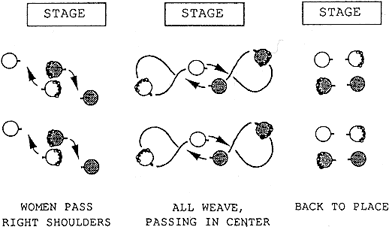
Figure 14. Hey for Four in "The Ritz"
The dancers begin the next round of the dance by weaving out of the "hey" and directly into a "right hand star" with the next couple below them in line.
This dance illustrates some of the ways the modern dances differ from the older traditional ones: The use of "fractional figures" (my term); the expansion of figures to include dancers outside the subgroup of four; the popularity of the "swing," especially the partner swing for everyone at once, done on the sides of the set; the use of half figures such as the half "ladies chain"; and the use of figures from other dance traditions such as the "hey" from English country dance. These and other basic figures are described and illustrated in the Appendix, and the reader is urged to familiarize himself or herself with these figures before proceeding.
The Music
As noted above, a contra dance tune is usually of the form AABB, each phrase being eight measures (or sixteen beats) long. One repetition of the typical contra dance is thus thirty-two measures long, or sixty-four beats long. (Exceptions do occur, including tunes of the form ABAB and tunes that are not thirty-two bars in length, but they are less common.) This format of four eight-measure sections is used by callers and choreographers in notating contra dances on paper, and in discussing the moves of a contra dance with one another. In conversation, a caller might refer to the circle "in the first A part" or the swing "in the second B part." The dancers may be less aware of the structure of the music and how it fits the structure of the dance, especially when they are beginners. However, it is essential for a caller to understand this relationship in order to call a dance.
Traditionally some dances such as "Hull's Victory," "Chorus Jig," "Rory O'More," and "Petronella" have always been danced to particular tunes by the same names. Contemporary contra dances are not generally matched to specific tunes, although occasionally a choreographer will be inspired by a particular tune to write a dance that works well with that tune. As a rule, however, a modern contra dance is danced to many different tunes, depending on the capabilities of the band and the preferences of the caller.
A contra dance band can consist of a single instrumentalist—a fiddle player or an accordionist, for example—but most typically there will be several musicians. Melody instruments, such as the fiddle, accordion, flute or tin whistle, banjo, or mandolin, provide the musical phrase that accompanies the dance. Bass instruments, such as the piano, guitar, or bass fiddle, provide the downbeat, which helps the dancers dance in time with the music. Rhythm instruments, such as the guitar, piano, or banjo, provide the upbeat or "lift," which gives the dancers support in moving to the music. Percussion instruments, such as spoons or wood blocks, accent the music and provide variety in the sound (Morningstar 1982). Musicians are also experimenting with drums (Sutherland 1990) and with brass instruments and woodwinds, such as the trombone, oboe, clarinet, and tuba, bringing back some of the instrumentation of the dance bands in the early part of this century.
